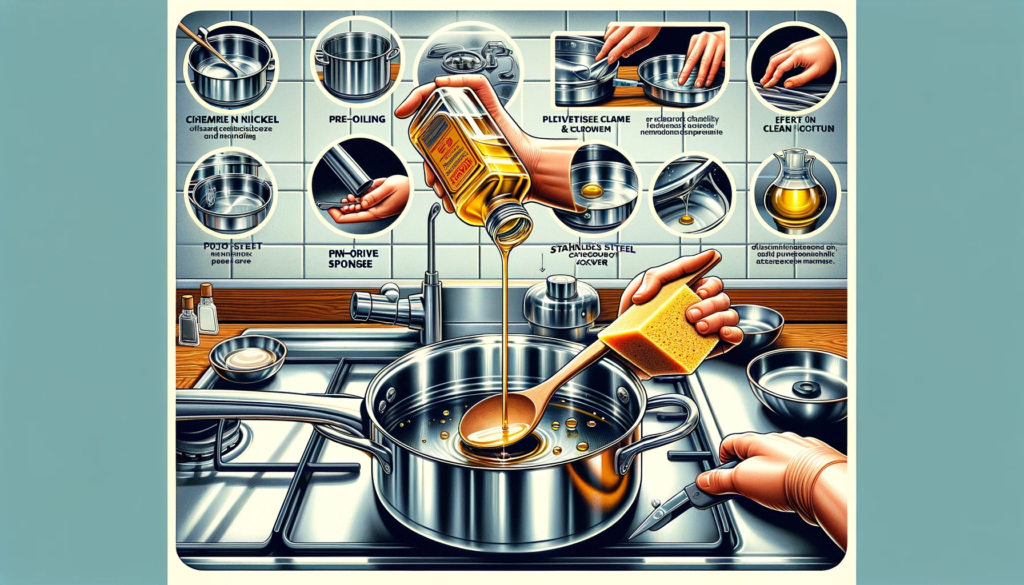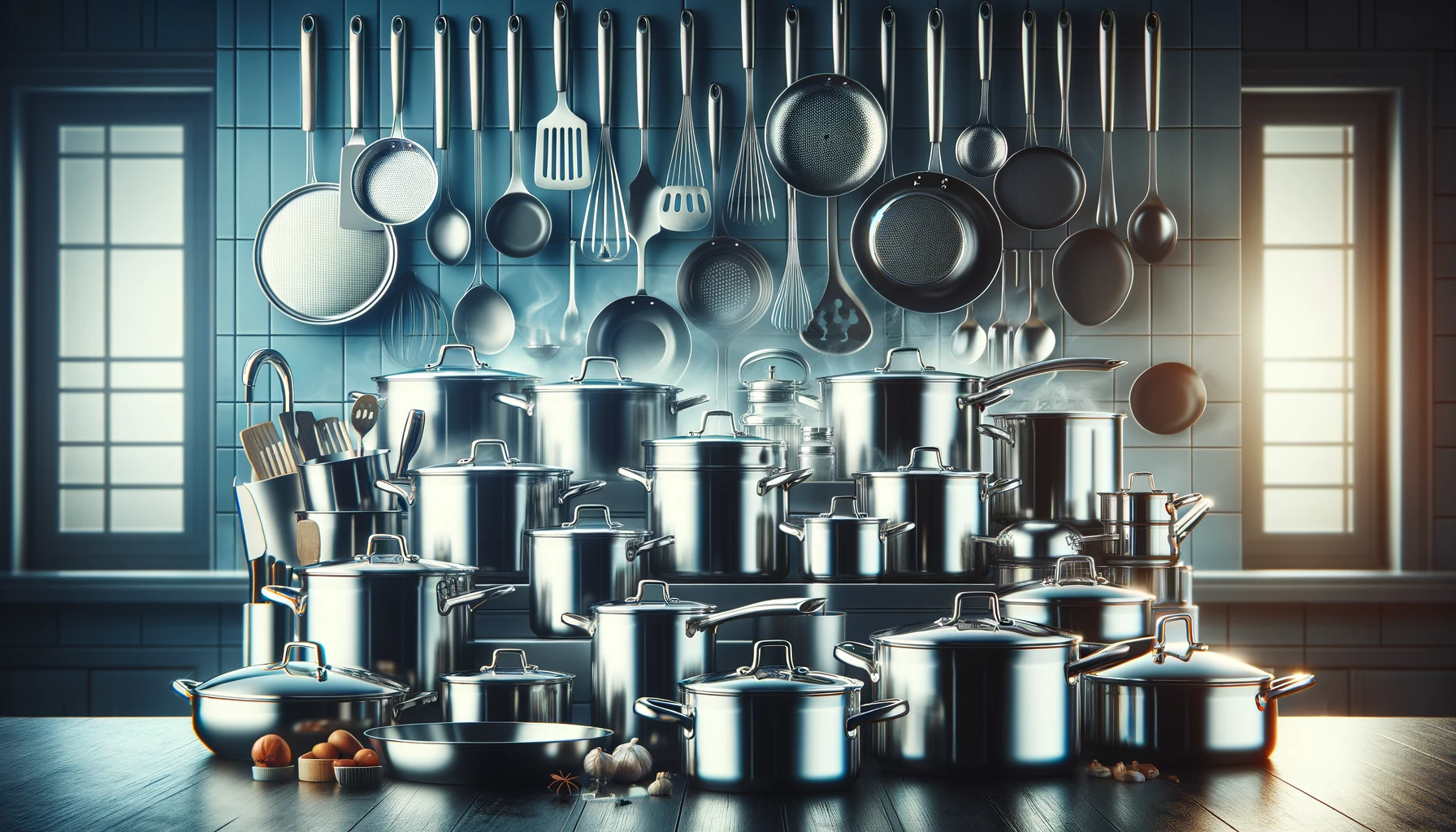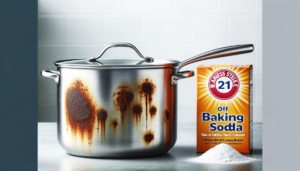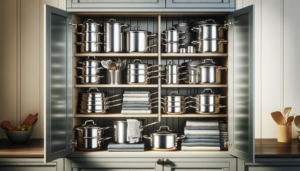Have you ever hesitated to buy a set of shiny new stainless steel pots over question marks whether constantly cooking with metal pans could somehow raise your family’s cancer odds?
While stainless steel alloys contain trace metals like nickel and chromium that at vastly higher airborne doses pose toxicity and cancer risks in industrial settings, extensive scientific testing and population studies confirm using stainless steel cookware as directed carries no credible carcinogenic hazards via diet.
Let’s examine what the latest evidence reveals and why experts overwhelmingly deem stainless steel cookware safe for continued everyday use with basic precautions.
Does Stainless Steel Cookware Cause Cancer?

No, using stainless steel cookware does not cause cancer.
Extensive scientific testing and population-level studies confirm stainless steel pots and pans, when used properly, pose negligible cancer risk even with daily long-term use.
But minimal amounts of metals like nickel and chromium can leach into foods cooked under extreme conditions or in damaged cookware.
Below we’ll explore the latest evidence and science around stainless steel cookware’s safety profile more closely.
What is Stainless Steel Cookware?

Stainless steel is an iron alloy containing at least 10.5% chromium along with elements like nickel, manganese, titanium, copper and silicon added in varying amounts.
The chromium generates a protective transparent oxide layer on the steel surface which resists corrosion, rusting and staining even under repeated high temperature cooking exposure over months and years.
This durability, scratch resistance and low-maintenance quality have made stainless steel an immensely popular cookware material over the past century.
Stainless steel pots and pans distribute heat quickly and evenly across the base and up the sides.
They can withstand very hot cooking temperatures above 500°F without warping or releasing noxious fumes.
The smooth stainless surface will not react with or absorb food odors and flavors either.
And stainless steel cookware cleans up easily in soapy water without requiring scouring or harsh chemical cleaners that might compromise the protective layer.
Taken together, these attributes make stainless steel an ideal and safe cookware material for everything from simmering sauces and stir-frying vegetables to searing meats day after day.
Claims Linking Stainless Steel Cookware and Cancer

However, there have been sporadic claims over the decades that using stainless steel cookware could potentially increase cancer risk under certain circumstances.
The main concerns center around small amounts of metals like chromium and nickel possibly leaching out of cookware into foods, especially when pans become extremely hot during cooking procedures.
Chromium and nickel compounds at very high industrial exposure levels are confirmed carcinogens linked to lung, nasal and sinus cavity cancers among factory workers facing constant inhalation of metal-laden dusts and fumes.
So could minute traces of these metals migrating from cookware into meals pose any genuine cancer danger to average households utilizing stainless steel pots and pans? Let’s closely examine what the balance of evidence actually suggests regarding this persistent safety question.
Why Are There Concerns About Chromium and Nickel Exposure From Cookware?
First, it will help to understand the roots of fears over exposure to traces of chromium and nickel from stainless steel cookware.
Chromium is intentionally added to stainless steel metallurgy at 10.5 to 20% concentrations in order to generate the highly stable passive chromium oxide film barrier that prevents surface oxidation (rust) and corrosion of the base metal alloy.
Meanwhile, nickel constituents ranging between 8 to 10% give stainless steel heightened physical durability, workability and thermal resistance allowing it to withstand repeated high temperature cooking episodes.
Now while both chromium and nickel nutrients are essential to human health and metabolism in tiny amounts, hexavalent chromium (CrVI) and nickel compounds in very concentrated forms are also confirmed human carcinogens through inhalation exposure pathways.
For example, workers in old chrome electroplating factories constantly breathing in chromium-laden dusts and mists developed inflamed sinuses and higher rates of lung cancers.
There are also clearly established links between refinery workers facing routine extreme airborne exposures to nickel fumes and powders manifesting as nickel sulfate and the emergence of nasal and sinus cancers.
So given chromium and nickel’s toxicity potential through lung/nasal tissue damaging and cancer connections when inhaled at vastly higher industrial levels on a daily basis, questions have emerged whether trace amounts of these metals occasionally leaching from stainless steel pans into foods could pose any cancer risks through ingestion as well.
Evidence on Stainless Steel Cookware Safety

So does using stainless steel pans and pots to fry, sear, simmer or bake foods actually cause enough cumulative dietary chromium or nickel intake through metal leaching to tangibly impact human cancers risks even marginally over long periods of time? Extensive research data indicates exposure risks are likely still minimal with ordinary stainless steel cookware use for these reasons:
Carefully Controlled Studies Show Very Low Leaching During Typical Cooking
The first line of evidence demonstrating stainless steel’s general safety comes from tightly managed laboratory experiments explicitly testing cookware metal leaching under different heating scenarios.
Tests have cooked highly acidic liquids like lemon juice, tomatoes and wine for 1-10 hours at temperatures up to 700°F in bare stainless steel pots to deliberately deconstruct corrosion resistance.
They found acidic solutions did extract trace quantities of iron, nickel and chromium approximating at 0.1 to 0.6 mg per kg of food.
Additional tests boiling water alone for 6 straight hours extracted up to 80 micrograms combined metals per liter.
However, significantly researchers found negligible measurable leaching from cookware with unblemished intact surfaces using less extreme household cooking conditions of shorter 1-2 hour durations for soups, sauces and meats.
Repeated findings show extremely limited metal migration into food given reasonable real-world cooking habits.
While critics contend laboratory experiments still extracted concerning heavy metals, crucial perspective is that these reference ranges relied on impractical prolonged heating of potentially corrosive liquids essentially never replicated in home kitchens.
As will be explored next, actual population research studies add confirming evidence that regular stainless steel use poses no elevation of ingestion risks.
Extensive Population Research Links No Elevated Cancer Risk
The most persuasive case demonstrating stainless steel cookware’s general safety comes from numerous large-scale population studies tracking the lifetime usage habits and health outcomes of thousands of adults across 10-15 years.
Two major research reviews examined data from over 22,000 and 118,000 people respectively.
Notably they discovered no statistically significant higher incidence rates of lung, gastrointestinal, esophageal or other cancers among adults using stainless steel cookware daily compared to the cancer rates in control groups of people rarely or never using it.
This broad-based epidemiological data matches controlled evidence showing highly minimal real-world metal exposure transfer from stainless steel even with daily extended use spanning years or decades.
Had substantial leaching and ingestion been transpiring, elevated risk markers would be expected in extensive long-range testing results.
In contrast, workers inhaling 100 to 1,000 times greater airborne chromium and nickel levels in industries have manifested clear lung and sinus health impacts – affirming realistic hazards only emerge after years of intensive exposures exceeding leaching trace amounts.
Tiny Exposure Quantities Lack Realistic Carcinogenic Potential
When still careful perspectives around stainless steel cookware safety are applied, supposed ingestion exposure threats appear even more improbable.
Given hexavalent chromium and carcinogenic nickel particles’ only established pathway to inducing cancer is through cellular-damaging, mutation-triggering chronic high dose inhalation over months and years, remarkably minute amounts occasionally transferred into foods seem highly unlikely to accumulate to levels necessary to genuinely impact disease risks.
With comprehensive evidence that stainless steel leaches barely detectable micro-doses of metals if at all while cooking typical recipes, and additional filtration by the human digestive system, lifecycle consumption patterns would remain thousands-fold below concerning quantities even for smaller children or infants.
Further, chromium and nickel’s limited biological uptake and absorption by digestive organs minimizes incorporation from diet.
With exposure rates never remotely approaching concentrations implied in confirmed occupational cancers, stainless steel cookware as conventionally used poses no credible or deterministic toxicity threats based on current understanding.
Still, because cookware durability can degrade over years of use, prudent usage tips further assure utmost safety.
Care Tips for Safe Use of Stainless Steel Cookware

While extensive testing has verified stainless steel’s admirable safety across decades of Ordinary household use, following certain best practice cooking and storage methods further reduces risks from metal leaching:
Refrain From Extreme Overheating of Empty Pots
Intentionally heating empty stainless steel pots deprives the metal surface of temperature moderation provided by cooking liquids.
Rapid uncontrolled heat above 800°F can damage the protective chromium oxide layer.
This allows heightened iron and nickel leaching.
Always pre-oil pans or add liquid ingredients first before heating cookware.
Utilize Non-Abrasive Cleaning Supplies to Avoid Scratching
Heavy scrubbing with steel wool pads or abrasive cleaners will eventually scratch and erode stainless steel’s surface oxidation layer.
Over time this allows deeper iron constituents to leach out while cooking acidic recipes.
Instead use non-scratch sponges and gentle agents like baking soda paste or vinegar solutions to safely clean stainless steel without impairment.
Opt for Cookware Containing Enough Chrome and Nickel
When purchasing stainless steel pots and pans, prioritize adequately high 18% chromium and 8% nickel content.
This preserves corrosion resistance following repeated dishwasher cycles or years of high temperature stove-top cooking.
Consider upgrading appliances showing visible thinning, erosion or metal warping.
Be Diligent About Detecting Damage or Excessive Wear
While durable, stainless steel cookware won’t survive forever with continual high-heat exposure.
Inspect older pots and pans for visible base metal peaking through indicators like round darkened spots or microscopic dents resembling punctures signaling loss of the protective barrier.
Any cookware exceeding 3 to 4 years should get checked annually for impaired safety.
Proactively replacing severely worn pans prevents heightened metal leaching into food later on.
Reassurances From Health Agencies and Cancer Experts

Reinforcing extensive research indicating the essential non-toxicity of stainless steel for home cookware, several governmental health agencies, cancer information organizations and doctors have affirmed its ongoing safety for consumers:
FDA Review Confirms No Meaningful Risk Exists
Seeking to clarify public questions over metals ingestion from cooking practices, the U.S.
Food and Drug Administration undertook extensive evaluative review of published leaching experiment findings paired with epidemiological studies and risk analyses around stainless steel cookware utilization.
Their toxicological assessment concluded occasional trace nickel or chromium migration into cooked food, even if detectable, still registered thousands of times below concerning chronic dose levels for adults and children that might theoretically impact disease predispositions.
Thus FDA corroborated stainless steel as an enduring safe cooking material option given ordinary care and upkeep employed.
Cancer Research Charities Verify Negligible Carcinogenic Potential
Seeking to keep cancer information grounded in validated research, resources like the American Cancer Society and Cancer Council Australia have also assessed available randomized trials and population research around stainless steel cookware usage patterns not indicating any exposure-induced malignancy risk upticks even with daily lifelong use.
Their medical consultants note findings most significant to human health align with occupational inhalation toxicity pathways irrelevant to trace food ingestion.
Therefore they advise patients no credible cancer risk basis exists to necessitate avoiding stainless steel cooking tools given vast margin of safety.
Oncologists Emphasize No Established Disease Correlations
To address sporadic patient inquiries, major cancer hospitals and oncology associations have also issued advisories reinforcing no current evidence from decades of monitoring connects routine stainless steel cookware use with increased gastrointestinal, lung, or nasal tumor incidences.
They underscore how definite inhalation toxicity differs enormously from passive diet ingestion of trace metals sometimes leaching from cookware, with exposure amounts far below levels possibly influencing cell-level disease triggers.
For these reasons doctors consistently emphasize to patients no established or theoretical cancer links exist necessitating patients avoid properly maintained stainless steel pots, pans or utensils given present understanding.
Conclusion
In conclusion, extensive scientific evidence supports the ongoing safe use of properly maintained stainless steel cookware in household cooking.
While sporadic traces of metals like nickel or chromium can migrate into food, especially when pans become extremely overheated, consumption exposure levels remain thousands of times below those linked to occupational inhalation toxicity.
With no population studies showing elevated cancer rates with stainless steel cookware use, and reassurances from governmental health agencies and cancer research organizations, consumers can confidently utilize these versatile pots and pans to meet everyday cooking needs without excess concerns over cancer risks.



